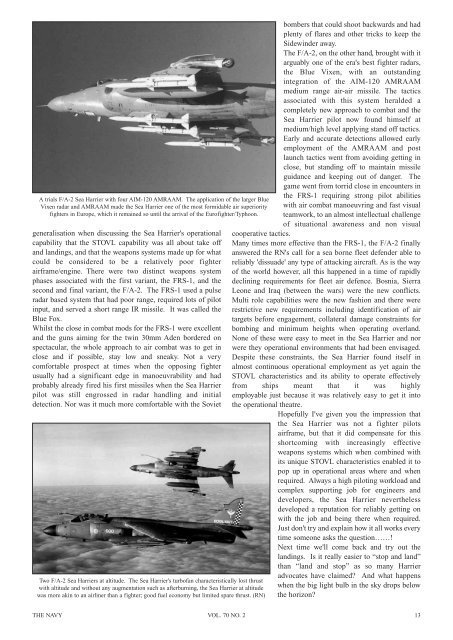The Navy Vol_70_No_2 Apr 2008 - Navy League of Australia
The Navy Vol_70_No_2 Apr 2008 - Navy League of Australia
The Navy Vol_70_No_2 Apr 2008 - Navy League of Australia
You also want an ePaper? Increase the reach of your titles
YUMPU automatically turns print PDFs into web optimized ePapers that Google loves.
A trials F/A-2 Sea Harrier with four AIM-120 AMRAAM. <strong>The</strong> application <strong>of</strong> the larger Blue<br />
Vixen radar and AMRAAM made the Sea Harrier one <strong>of</strong> the most formidable air superiority<br />
fighters in Europe, which it remained so until the arrival <strong>of</strong> the Eur<strong>of</strong>ighter/Typhoon.<br />
generalisation when discussing the Sea Harrier's operational<br />
capability that the STOVL capability was all about take <strong>of</strong>f<br />
and landings, and that the weapons systems made up for what<br />
could be considered to be a relatively poor fighter<br />
airframe/engine. <strong>The</strong>re were two distinct weapons system<br />
phases associated with the first variant, the FRS-1, and the<br />
second and final variant, the F/A-2. <strong>The</strong> FRS-1 used a pulse<br />
radar based system that had poor range, required lots <strong>of</strong> pilot<br />
input, and served a short range IR missile. It was called the<br />
Blue Fox.<br />
Whilst the close in combat mods for the FRS-1 were excellent<br />
and the guns aiming for the twin 30mm Aden bordered on<br />
spectacular, the whole approach to air combat was to get in<br />
close and if possible, stay low and sneaky. <strong>No</strong>t a very<br />
comfortable prospect at times when the opposing fighter<br />
usually had a significant edge in manoeuvrability and had<br />
probably already fired his first missiles when the Sea Harrier<br />
pilot was still engrossed in radar handling and initial<br />
detection. <strong>No</strong>r was it much more comfortable with the Soviet<br />
Two F/A-2 Sea Harriers at altitude. <strong>The</strong> Sea Harrier's turb<strong>of</strong>an characteristically lost thrust<br />
with altitude and without any augmentation such as afterburning, the Sea Harrier at altitude<br />
was more akin to an airliner than a fighter; good fuel economy but limited spare thrust. (RN)<br />
bombers that could shoot backwards and had<br />
plenty <strong>of</strong> flares and other tricks to keep the<br />
Sidewinder away.<br />
<strong>The</strong> F/A-2, on the other hand, brought with it<br />
arguably one <strong>of</strong> the era's best fighter radars,<br />
the Blue Vixen, with an outstanding<br />
integration <strong>of</strong> the AIM-120 AMRAAM<br />
medium range air-air missile. <strong>The</strong> tactics<br />
associated with this system heralded a<br />
completely new approach to combat and the<br />
Sea Harrier pilot now found himself at<br />
medium/high level applying stand <strong>of</strong>f tactics.<br />
Early and accurate detections allowed early<br />
employment <strong>of</strong> the AMRAAM and post<br />
launch tactics went from avoiding getting in<br />
close, but standing <strong>of</strong>f to maintain missile<br />
guidance and keeping out <strong>of</strong> danger. <strong>The</strong><br />
game went from torrid close in encounters in<br />
the FRS-1 requiring strong pilot abilities<br />
with air combat manoeuvring and fast visual<br />
teamwork, to an almost intellectual challenge<br />
<strong>of</strong> situational awareness and non visual<br />
cooperative tactics.<br />
Many times more effective than the FRS-1, the F/A-2 finally<br />
answered the RN's call for a sea borne fleet defender able to<br />
reliably 'dissuade' any type <strong>of</strong> attacking aircraft. As is the way<br />
<strong>of</strong> the world however, all this happened in a time <strong>of</strong> rapidly<br />
declining requirements for fleet air defence. Bosnia, Sierra<br />
Leone and Iraq (between the wars) were the new conflicts.<br />
Multi role capabilities were the new fashion and there were<br />
restrictive new requirements including identification <strong>of</strong> air<br />
targets before engagement, collateral damage constraints for<br />
bombing and minimum heights when operating overland.<br />
<strong>No</strong>ne <strong>of</strong> these were easy to meet in the Sea Harrier and nor<br />
were they operational environments that had been envisaged.<br />
Despite these constraints, the Sea Harrier found itself in<br />
almost continuous operational employment as yet again the<br />
STOVL characteristics and its ability to operate effectively<br />
from ships meant that it was highly<br />
employable just because it was relatively easy to get it into<br />
the operational theatre.<br />
Hopefully I've given you the impression that<br />
the Sea Harrier was not a fighter pilots<br />
airframe, but that it did compensate for this<br />
shortcoming with increasingly effective<br />
weapons systems which when combined with<br />
its unique STOVL characteristics enabled it to<br />
pop up in operational areas where and when<br />
required. Always a high piloting workload and<br />
complex supporting job for engineers and<br />
developers, the Sea Harrier nevertheless<br />
developed a reputation for reliably getting on<br />
with the job and being there when required.<br />
Just don't try and explain how it all works every<br />
time someone asks the question……!<br />
Next time we'll come back and try out the<br />
landings. Is it really easier to “stop and land”<br />
than “land and stop” as so many Harrier<br />
advocates have claimed? And what happens<br />
when the big light bulb in the sky drops below<br />
the horizon?<br />
THE NAVY VOL. <strong>70</strong> NO. 2 13

















